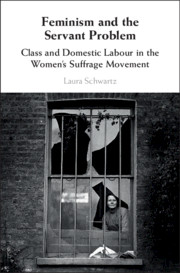Book contents
- Feminism and the Servant Problem
- Feminism and the Servant Problem
- Copyright page
- Contents
- Figures
- Acknowledgements
- Introduction
- 1 The ‘Servant Problem’ and the Suffrage Home
- 2 Servants in the Suffrage Movement
- 3 The Housework Problem
- 4 Domestic Labour and the Feminist Work Ethic
- 5 The Domestic Workers’ Union of Great Britain and Ireland
- 6 Servants and Co-operative Housekeeping
- Conclusion
- Select Bibliography
- Index
Introduction
Whose Problem Was the ‘Servant Problem’?
Published online by Cambridge University Press: 19 July 2019
- Feminism and the Servant Problem
- Feminism and the Servant Problem
- Copyright page
- Contents
- Figures
- Acknowledgements
- Introduction
- 1 The ‘Servant Problem’ and the Suffrage Home
- 2 Servants in the Suffrage Movement
- 3 The Housework Problem
- 4 Domestic Labour and the Feminist Work Ethic
- 5 The Domestic Workers’ Union of Great Britain and Ireland
- 6 Servants and Co-operative Housekeeping
- Conclusion
- Select Bibliography
- Index
Summary
In November 1911 the suffragist newspaper the Common Cause published a letter from a woman who had worked in service since the age of thirteen. Identifying herself only as ‘Another Servant’, she objected not only to hard working conditions and harsh employers, but also to the complacency of the suffrage movement. ‘Why don’t suffragists begin their reform work at home …?’, she demanded, ‘why don’t they try in some way to relieve the monotonous life of the domestic servant? If they want equality with men, why cannot they put servants on twelve hours a day shift, like the majority of workmen[?]’1 The Common Cause was in fact quite open to discussing the ‘servant problem’, publishing many letters from readers who were both servants and mistresses. A month later, a cook general named Kathlyn Oliver (1884–1953), who had founded the Domestic Workers’ Union almost two years earlier, wrote offering a more optimistic perspective on the relationship between servant militancy and women’s emancipation, insisting, ‘This servant agitation belongs to the feminist movement.’2
- Type
- Chapter
- Information
- Feminism and the Servant ProblemClass and Domestic Labour in the Women's Suffrage Movement, pp. 1 - 28Publisher: Cambridge University PressPrint publication year: 2019

